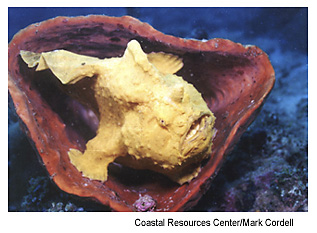Promoting Marine and Coastal Protected Areas for Sound Development and Biodiversity Conservation
 |
A Commerson’s frogfish rests in a coral in the Lembi Straits
off North Sulawesi, Indonesia. |
Marine and coastal protected areas have been shown to be critical components for the sustainable use and conservation of coastal resources, and thus for securing livelihoods, fisheries and food resources, and biodiversity conservation. Marine, coastal, and estuarine protected areas range from small, locally managed and enforced fishery reserves (also known as no-take ecological reserves) to larger national marine parks that are zoned for multiple use. Integrated coastal management programs incorporate marine protected areas as critical components of their strategic approach to sound development and governance. Marine protected areas serve many functions within larger coastal management programs—from early demonstration sites for local governance, to demonstrations of concrete fisheries benefits through the use of no-take ecological reserves. Benefits include:
- Strengthened management of parks and protected areas;
- Habitat and biodiversity conservation through threat mitigation;
- Improved environmental management by both public and private sector entities;
- Sustained livelihoods, employment diversification, and income generation;
- Reduction of negative impacts from international trade and destructive fishing practices;
- Sustainable tourism and fisheries; and
- Reduction of land-based sources of pollution and improved coastal watershed management.
Supporting the Goals of the World Summit on Sustainable Development and the World Parks Congress
At the 2002 World Summit on Sustainable Development (WSSD), also known as the U.N. Johannesburg Summit, international leaders called for the establishment by 2012 of a global system of representative networks of marine and coastal protected areas, consistent with international law and based on best available scientific information. International leaders also called for the development and facilitation of an ecosystem-based approach to management; elimination of destructive fishing practices; time/area closures for the protection of nursery grounds and periods; proper coastal land use and watershed planning, and the integration of marine and coastal areas management into key sectors; and development of national, regional, and international programs for halting the loss of marine biodiversity, including in coral reefs and wetlands.
At the 5th IUCN World Parks Congress in 2003 in Durban, South Africa, participants discussed the important role of protected areas in preventing and alleviating poverty; how protected areas adapt and anticipate global change—biophysical, economic, and social; the place of protected areas as part of our sustainable future; and the contribution of protected areas to security. The Congress is an event held every ten years that provides the major global forum for setting the agenda for protected areas. Marine and coastal programs funded by USAID support the United States’ commitment to the goals of the WSSD and the World Parks Congress.
MPAs as Ecological Reserves and Fisheries Management Tools
Ecological “no-take” reserves, where fishing and other extractive activities are not allowed, and/or multi-purpose marine protected areas are especially effective coastal management approaches that can result in early and sustained management dividends. When critical feeding, nursery, and spawning sites are protected, ecological reserves can improve fishery yields and help build and maintain healthy fish populations. Ecological reserves have also proven very effective in the conservation of marine biodiversity and the generation of jobs and revenue through tourism. Such tools, when coupled with ongoing education, enforcement, and sustained livelihood schemes, offer the best hope for reducing or eliminating stress on coral reefs and other marine habitats.
USAID is supporting marine and coastal protected areas in more than 20 countries, including parks of national, regional and international importance. In Latin America and the Caribbean, USAID supports The Nature Conservancy’s Parks in Peril Program, which strengthens protected area management through ecoregional and site-based approaches. Activities include strengthening protected areas management and policy for protection of critical spawning aggregation sites, no-take fisheries and biodiversity reserves, and co-management schemes.
Networks of Marine Protected Areas for Resiliency and Large-scale Impact
The establishment of networks of marine protected areas is an especially critical strategy for maintaining resource productivity, enhancing resiliency, and ensuring protection of marine and coastal habitats. In partnership with the International Coral Reef Action Network, The Nature Conservancy, the Wildlife Conservation Society, the World Wildlife Fund, and other partners, USAID is supporting the establishment of networks of marine protected areas in the Meso-American Reef Ecoregion in Central America and Mexico; Eastern Caribbean and Lesser Antilles; Sulu-Sulawesi Sea Ecoregion in Indonesia, Malaysia, and the Philippines; Tukang Besi (Wakatobi) Islands of Sulawesi, Indonesia; Raja Ampat islands of Papua, Indonesia; Kimbe Bay and Bismarck Sea, Papua New Guinea; Eastern African Marine Ecoregion in Kenya, Tanzania, Mozambique, and South Africa; and national networks in Jamaica, Indonesia, and the Philippines.
Transboundary Marine Protected Areas
Some marine reserves, and the management issues they entail, extend across country boundaries and require transboundary resource planning and management, as well as the development of regional initiatives or programs. Through the Middle East Regional Cooperation program, USAID is promoting cooperation between Israel and Jordan on research and management of shared resources in the Red Sea Marine Peace Park. Through the PROARCA/APM regional program in Central America, USAID is strengthening regional and transboundary management of coastal resources in the Gulf of Honduras along the Guatemala/Belize/ Honduras borders, the Miskito Coast of Honduras and Nicaragua, and the Amistad Cahuita Rio Canas area of Panama and Costa Rica.
Back to Top ^


